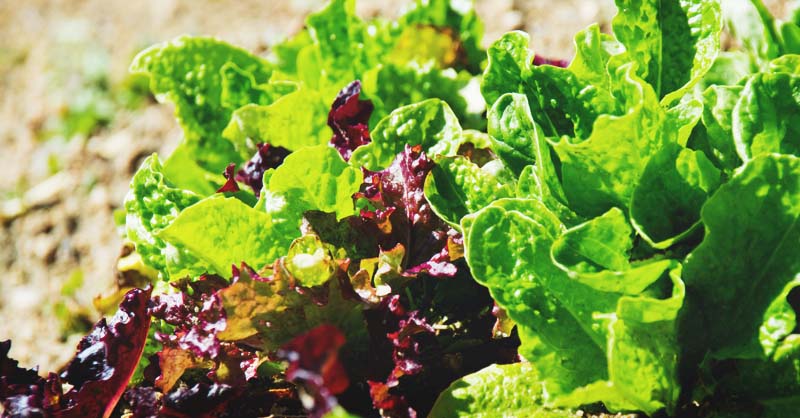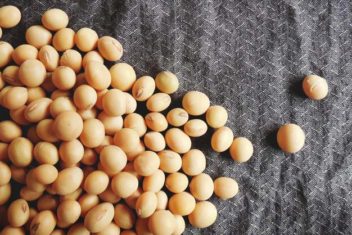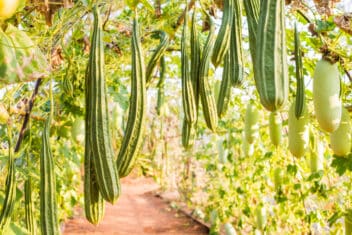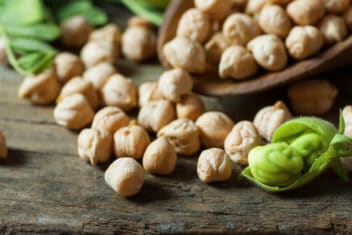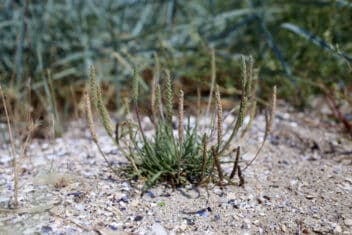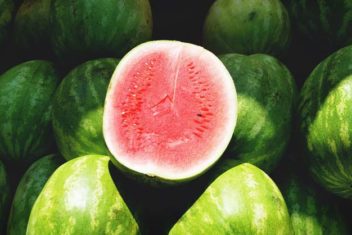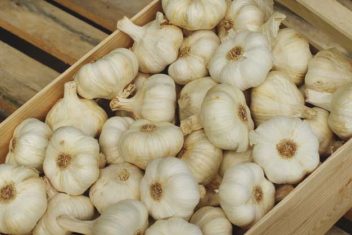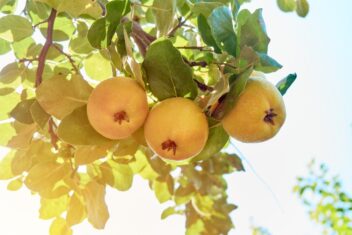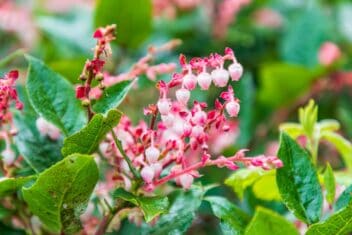Have you ever seen one of those gorgeous containers of red, green, and purple leaves growing on a patio? Those beautiful greens are mesclun. Mesclun isn’t one particular plant, rather, it’s a mixture of lettuces that includes a variety of other types of greens (e.g., mustards) for flavor and texture.
Over the years, I’ve tried lots of different mesclun mixes, but it’s a challenging crop to grow because of the hot summers here. Still, I prefer sowing mesclun over planting individual heads of lettuce and other greens. I love the surprises that pop up (I never read the seed packet contents thoroughly, because I enjoy the mystery involved when I sow blindly).
I always have a mesclun seed packet on hand for sowing in the garden. There’s nothing better than snipping off a handful of greens only to discover the tasty surprise when you dig into your salad. If you’re wondering why you should plant this delightful mix of greens and how to go about doing so, read on.
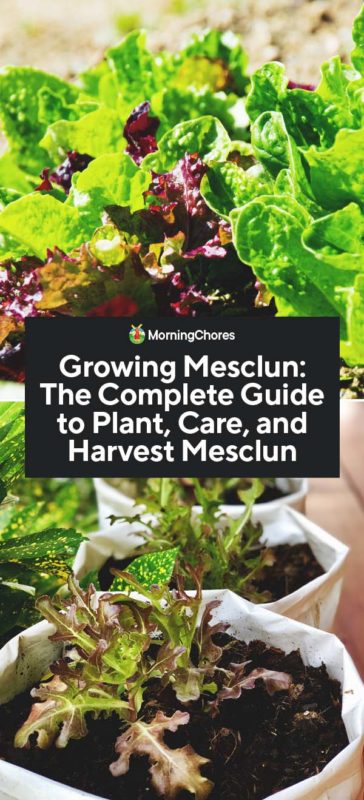
Why Grow Mesclun?
Wondering what the benefits are of growing mesclun over a single type of lettuce? Here are a few reasons to consider planting this type of crop:
- Quick growing. Often, mesclun mixes contain greens that are quick to grow or are specially chosen because they taste best when harvested young. The quick-growing nature of mesclun makes it appropriate for short-season growing or last-minute sowing. It’s also an excellent candidate for succession sowing.
- Variety of textures and flavors. A salad that contains a single type of lettuce is incredibly dull — visually and texturally. Use mesclun to put together salads that are far more interesting and delicious.
- Visually appealing. A dense cropping of mesclun looks great growing in the garden. The mix of colors and textures is a great way to quickly add vibrancy to your garden space.
- Available in different flavor mixes. If you’re not a fan of spicy, bitter-tasting greens, don’t worry. You can choose from an array of mesclun mixes from mild to spicy.
- Easy to grow. It doesn’t take an advanced degree in agriculture to grow mesclun successfully. Like lettuce and most other greens, mesclun is simple to cultivate.
- One-shot salad. You don’t need to sow a variety of greens around your garden to create a scrumptious salad. Everything you need for a tasty bowl of greens is contained in a single packet.
- No need to buy seeds separately. Growing a mix of greens is inexpensive thanks to ready-to-purchase mesclun seed mixes. You don’t need to buy large packets of seed and grow everything separately when using mesclun seed mixes. It’s not only easy on your wallet, but it also reduces seed waste, as well.
What’s Typically Included in a Mesclun Mix
Mesclun seed mixes include a myriad of seed types. Here are some of the most commonly included vegetables included in a mesclun mix. A blend may contain some or all of these:
- Lettuces (often leaf-type)
- Arugula
- Endive and radicchio
- Herbs (chervil, dandelion, parsley)
- Mustard greens and mizuna
- Mache
- Spinach
- Swiss chard
- Kale
- Chicory
- Other Asian greens
- Watercress
Mesclun Mixes
Mesclun mixes are often characterized by their flavor profile. They may also be labeled and named for what’s in the mix or how quickly it grows. Here are some examples of mesclun mixes available to purchase:
- Salad mix: Usually includes only lettuce, but consists of a combination of textures and colors.
- Provencal: A French salad blend that includes arugula, endive, lettuce, and chervil.
- Mustard mix: Includes a variety of mustard greens, can be eaten raw or stir-fried.
- Winter blend: Contains varieties that are cold-tolerant and often quite hardy.
- Spicy mix: Typically contains arugula or mustard greens (or both) for a spicy kick.
- Mild mix: Alternately, opt for a mix labeled as mild if you’re not fond of pungent tasting greens like arugula.
How to Plant Mesclun
Growing Zones
Mesclun, like many garden greens, is a cool-season crop that’s best grown in the late spring or early fall. It doesn’t do well in the heat of the summer, though it’s possible to grow mesclun during the hot months with a bit of effort. You can grow them in just about any zone that gets below 80°F for long enough.
Seed Sowing
Mesclun is typically direct sown into the garden and isn’t usually transplanted. To sow mesclun, broadcast the seeds evenly in a raised bed, container, or in-ground bed. Don’t sow the seeds too deeply. Instead, sprinkle them on the surface and gently tamp into the soil or cover them with a light application of dirt. Keep the seeds moist to ensure even germination. Water access is vital during the beginning growth stages of this crop.
Soil Requirements
Plant mesclun in rich, fertile soil to see it thrive. Use a pest cover to protect seedlings from insects, especially if you’re growing a mesclun mix that includes kale.
Sun Requirements
Mesclun can grow in sun to part shade. If you live in a warm area, plant in part shade. Use shade cloth during hot weather months to protect your mix from the sun.
Germination
Some seeds in a mesclun mix may take a bit longer to germinate, but the first sprouts should appear within a week.
Tips for Planting
Plant mesclun in a clean area of the garden. Weeds are a big problem with this type of crop because it’s often difficult to tell them apart from what you’re growing. An even soil line is also crucial as it makes for easier harvesting.
Container Growing
Mesclun is a great option for container growing since most greens don’t have deep root systems. You need to keep a closer eye on moisture levels if growing in containers.
How to Care for Mesclun
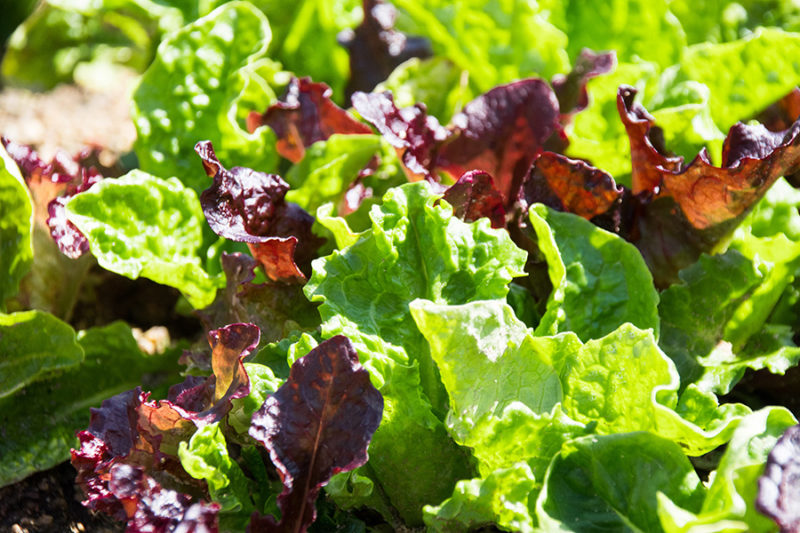
Watering
Keep your mesclun crop well-watered and avoid letting the soil dry out, especially in hot weather.
Mulch
Because mesclun grows densely and should be sown in a weed-free location, mulching is seldom required. The tightly spaced greens should maintain soil temps.
Pruning
As with all lettuce plants, pruning isn’t required. Use a cut-and-come-again harvesting method to ensure you get multiple harvests from a single crop.
Succession sowing
Sow mesclun every few weeks for a continuous supply for your dinnertime salad bowl.
Problems with Growing Mesclun
Problems are entirely dependent on what’s included in your preferred mesclun mix. Poor germination and high crop failure rates, however, are usually an issue with water access. Your mesclun needs frequent watering to prevent the plants from drying out.
In the heat of the summer, bolting is often an issue. Choose bolt-resistant varieties and use tools like shade cloth to help avoid this problem. If that’s not possible, try focusing your mesclun production in the spring and fall. Many greens, like lettuce and mustards, become bitter when exposed to prolonged bouts of heat, so summer growing of this crop isn’t ideal even if you can manage to prevent early bolting.
Lettuces are all subject to anthracnose, leaf drop, powdery mildew, and downy mildew. Slugs love to nibble on the leaves. Mustards may get leaf spot, clubroot, mildew, rust, and black rot. Also, watch for aphids and flea beetles.
Companion Plants for Mesclun
If the heat is a problem, plant tall plants nearby, like tomatoes, to provide cover for your mesclun. Plant pest-repelling flowers and herbs close by to keep away pests from whatever is included in your mix. You may even choose to grow edible flowers nearby and herbs like mint to add into your salad.
Harvesting Mesclun
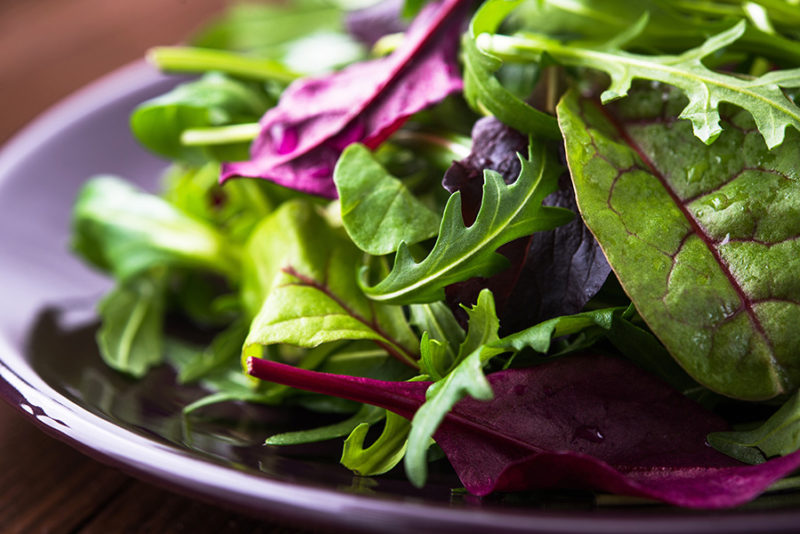
It’s time to harvest mesclun when greens reach at least 3 inches in height. The choice is yours, though. Wait a little longer for larger leaves or harvest when small for a salad of baby greens. Tender baby greens taste best, but there’s nothing wrong with waiting for a larger leafed harvest.
Most mesclun mixes include greens that can be cut and regrown, so you’ll get a few harvests from a single sowing. If growing mesclun at the height of the summer, you may prefer to keep your harvests from a single crop to a minimum because over time the greens may turn bitter and ultra-spicy if exposed to hot conditions. Expect at least two harvests and perhaps up to 4 depending on the weather and growing conditions.
You can use mesclun as you would any other salad green, but this recipe with crispy garlic and goat cheese is particularly delicious.
Make your own mesclun mix
Some gardeners may prefer to create their own mesclun seed mixes. Thankfully, the process is easy! Here are a few things to consider when combining seeds for growing mesclun:
Growth rate and days to maturity: Choose seeds that are likely to grow at the same rate and mature around the same time. The greens included in your mesclun mix should be ready for picking all at once.
Flavor: Choose flavors that complement one another and pick greens that suit your palate. If you prefer a milder mix, opt for mild mustards over hot spicy ones and avoid including arugula.
Texture: Select contrasting textures to create interest, or create a uniform mix if that’s what you prefer.
Bolt resistance: Pick bolt-resistant varieties to prevent plants in your mesclun mix from going to seed. You don’t want your kale ready for picking while your chosen lettuce is ready to flower.
